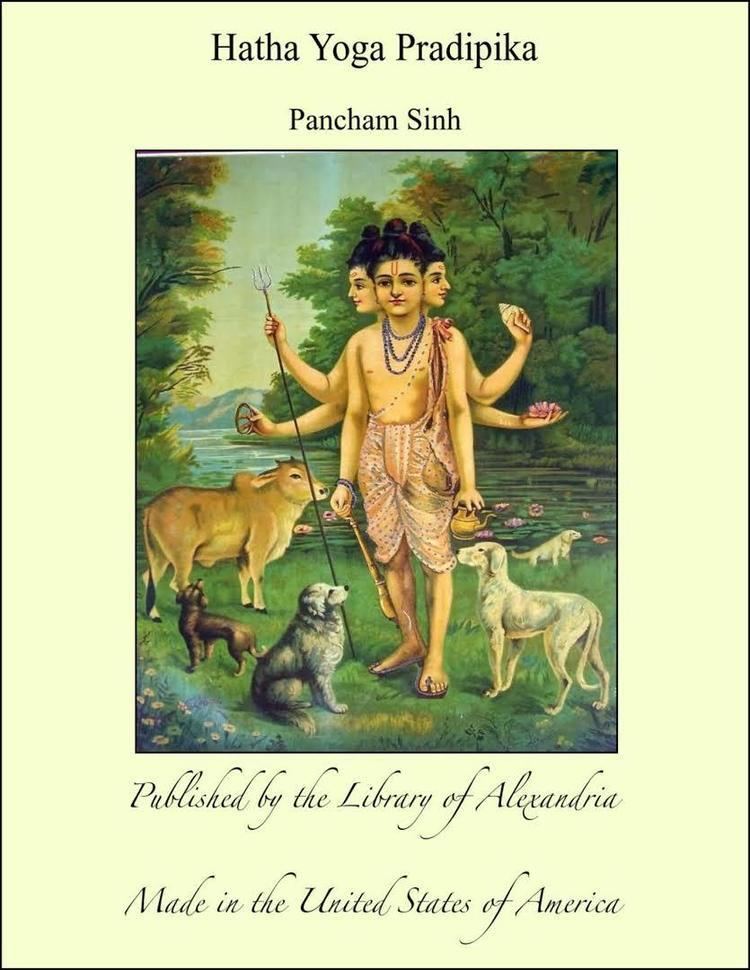 | ||
Similar Gheranda Samhita, Yoga Sutras of Patanjali, Shiva Samhita, Upanishads, Light on Yoga | ||
Hatha yoga pradipika guru stotram
The Hatha Yoga Pradīpikā (Sanskrit: haṭhayōgapradīpikā, हठयोगप्रदीपिका or Light on Hatha Yoga) is a classic Sanskrit manual on hatha yoga, written by Svāmi Svātmārāma, a disciple of Swami Gorakhnath. It is among the most influential surviving texts on hatha yoga. The Hatha Yoga Pradīpikā is also one of three classic texts on hatha yoga, alongside the Gheranda Samhita and the Shiva Samhita. Because this work originated so long ago, different manuscripts offer various versions of its title. The database of the A.C. Woolner manuscript project at the Library of the University of Vienna gives the following variant titles, gleaned from different manuscript colophons: Haṭhayogapradīpikā, Haṭhapradīpikā, Haṭhapradī, Hath-Pradipika.
Contents
The Hatha Yoga Pradīpikā was composed by Svātmārāma in the 15th century CE. as a compilation of the earlier hatha yoga texts. Svātmārāma incorporates older Sanskrit concepts into his popular synthesis. The Hatha Yoga Pradīpikā and the Gheranda samhita are derived from older Sanskrit texts. In the Hatha Yoga Pradīpikā, Svātmārāma introduces his system as preparatory stage for physical purification that the body practices for higher meditation or Yoga. It is based on asanas (postures) and pranayama (breathing techniques).
Summary
Hatha Yoga Pradīpikā lists 35 experienced hatha yoga siddhas or masters; Adi Natha, Matsyendranath and Gorakshanath. It consists of four chapters that include information about shatkarma (purification), asana (postures), pranayama (subtle energy control), chakras (centers of energy), kundalini (instinct), bandhas (muscle force), kriyas (techniques; manifestations of kundalini), shakti (sacred force), nadis (channels), and mudras (symbolic gestures), among other topics.
It runs in the line of Hindu yoga (to distinguish from Buddhist and Jain yoga) and is dedicated to Śrī (Lord) ādi nāthā (Adinatha), a name for Lord Shiva (the Hindu god of destruction and renewal), who is believed to have imparted the secret of haṭha yoga to his divine consort Pārvatī.
Modern Research
Recent research on the history of yoga has led to a more developed understanding of hatha yoga. In analyzing the Hatha Yoga Pradīpikā, as well as other works by Svātmārāma, researchers better understand the origins of hatha yoga.
Researcher and lecturer Dr. James Mallinson has thoroughly studied the origins of hatha yoga and has worked with classic yoga texts such as the Khecarīvidyā. He has identified a collection of eight works that introduce early hatha yoga and contribute directly to its official formation in the Hatha Yoga Pradipika. Many of his conclusions from these early works discredit what was previously thought about the formation of yoga.
Jason Birch of Oxford has investigated the evolution of the meaning of the Sanskrit word "hatha." He specifically researched the key role of the Hatha Yoga Pradīpikā in popularizing a particular interpretation of this term. When written, the Hatha Yoga Pradīpikā drew from various classic texts on different systems of yoga, and Svātmārāma grouped what he had found under the generic term "hatha yoga". Although hatha yoga has evolved into a generic term that is currently understood as a branch of yoga involving physical poses (including sun salutations, vinyasas, Asthanga, etc.), it originally had a more specific meaning. After examining Buddhist tantric commentaries and medieval yoga texts that came before the Hatha Yoga Pradīpikā, Birch found that the adverbial uses of the word suggests that it meant "force". Birch found that, "Rather than the metaphysical explanation of uniting the sun (ha) and moon (ṭha), it is more likely that the name haṭha yoga was inspired by the meaning 'force'."
